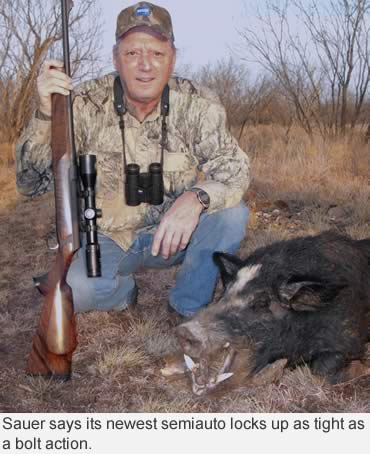By Jon R. Sundra
The 303 is a masterpiece of metal machining.
In many ways, the bolt-action rifle is an anachronism. It’s been around since the late 1830s and hasn’t really changed much since the definitive Mauser of 1898. Indeed, if we were to take a brand new rifle like a Winchester Model 70, Remington 700 or a Ruger 77, there’s virtually no difference in how they function or what they can do compared to a 100-year-old Mauser.
As far as hunters are concerned, if ever the bolt-action rifle succumbs to technology, it will be to the semiauto.
Until quite recently, the only major players on the semiauto big game rifle scene (I’m talking traditional rifles now, not ARs) were the various iterations of Remington’s Model 7400 and Browning’s BAR. Then came the Benelli R1 a few years back, and now the new German-made Sauer 303.
I had the opportunity to carry one of these guns chambered in .30-06 on a hog hunt in Texas this past February and was quite impressed with it.
Like its bolt-action sibling, the receiver of the 303 is a masterpiece of metal machining, a fact that becomes evident after removing the woodwork. The entire receiver and the well for the detachable magazine are one-piece, and because the multi-lug rotary bolt locks up directly with the barrel, not the receiver, it’s made of a lightweight alloy rather than steel.
Every current German-made centerfire rifle that comes to mind shares this same direct barrel locking feature. Integral, U-shaped recesses fore and aft on the receiver sidewalls engage tenons on the buttstock and fore-end. Everything fits with impressive precision.
 Like its 202 sibling and several other German rifles, the 303 is manually cocked by sliding a thumbpiece located atop the wrist upward and forward. Doing so compresses the firing pin. The gun can therefore be carried uncocked until the last second, a good safety feature. Both the cocking and uncocking movements are silent.
Like its 202 sibling and several other German rifles, the 303 is manually cocked by sliding a thumbpiece located atop the wrist upward and forward. Doing so compresses the firing pin. The gun can therefore be carried uncocked until the last second, a good safety feature. Both the cocking and uncocking movements are silent.
The iron sights, which come standard, are excellent, consisting of a TruGlo-type front bead and a yellow rear sight blade. Typical of European guns, the rear sight is well forward, resulting in the short sight radius that excels at short ranges and for the rapidly moving targets encountered on game drives and Monteria-type hunts. For scope use, a mounting rail is machined integral with the receiver to provide direct ring attachment; it’s the system I prefer.
Surprisingly, three of the gun’s four stock styles cater to American tastes. There’s a straight-comb classic, a Monte Carlo and a thumbhole stock, all of which are quite handsome.
Calibers offered this first year of availability are 7x64, .30-06, 8x57JS, 9.3x62 and .300 Winchester Magnum. Surely other calibers will be added.
The rifle I used in Texas sported a 22-inch barrel and weighed 7.2 pounds sans the Zeiss 1-6x variable I had mounted. The gun had a very nice balance and performed flawlessly.
Read Recent GunHunter Articles:
• The .308 Family: Offspring of the .308 are accurate, compact and easy to shoot.
• Mossberg’s New Lever Action: The Model 464 is a classic reborn.
This article was first printed in the July 2011 edition of Buckmasters GunHunter Magazine. Subscribe today to have GunHunter delivered to your home.